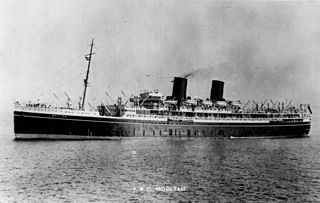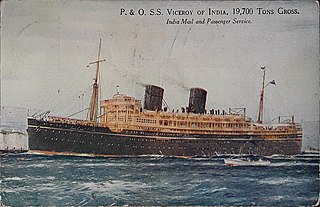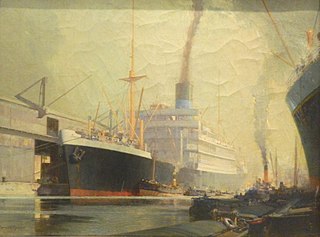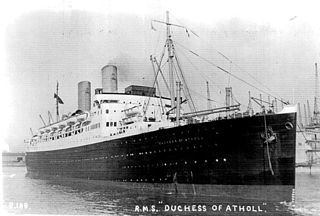
The Blue Star Line was a British passenger and cargo shipping company formed in 1911, being in operation until 1998.

SS Arandora Star, originally SS Arandora, was a British passenger ship of the Blue Star Line. She was built in 1927 as an ocean liner and refrigerated cargo ship, converted in 1929 into a cruise ship and requisitioned as a troopship in the Second World War. At the end of June 1940 she was assigned the task of transporting interned Anglo-Italian and Anglo-German civilians as well as a small number of legitimate prisoners of war to Canada. On 2 July 1940 she was sunk by a German U-boat off the coast of Ireland with a large loss of life, 805 people.

RMS Mooltan was an ocean liner and Royal Mail Ship of the Peninsular and Oriental Steam Navigation Company (P&O). She was ordered in 1918 and completed in 1923. She served in the Second World War first as the armed merchant cruiser HMS Mooltan (F75) and then as a troop ship. She was retired from P&O service in 1953 and scrapped in 1954.

RMS Viceroy of India was an ocean liner of the Peninsular and Oriental Steam Navigation Company (P&O). She was a British Royal Mail Ship on the Tilbury–Bombay route and was named after the Viceroy of India. In World War II, she was converted to and used as a troopship. She was sunk in the Mediterranean in November 1942 by German submarine U-407.
SS Volo was a British steam cargo ship that was built on Tyneside in 1938 and sunk by a German U-boat in the Mediterranean Sea off North Africa in 1941. 23 people on board the Volo died as a result of the attack.

SS Corinthic was a British cargo steamship. She was built on Teesside in 1924, sailed in a number of convoys in the Second World War, survived an overwhelming German attack on Convoy SC 7 October 1940, but was sunk by a German U-boat off West Africa in April 1941.
SS Patroclus was a UK steam turbine passenger and refrigerated cargo liner launched in 1923. She was the third of five ships to bear the name.

SS Sarpedon was a UK steam turbine passenger and refrigerated cargo liner launched in 1923. She was the fourth of six ships to bear the name.
SS Manistee was an Elders & Fyffes Ltd banana boat that was launched in 1920. She was one of a numerous class of similar banana boats built for Elders & Fyffes in the 1920s.
SS Kingston Hill was a cargo ship built by William Hamilton & Co in Port Glasgow on the Firth of Clyde. She was completed in December 1940. She was managed by Counties Ship Management Co Ltd of London (CSM), an offshoot of the Rethymnis & Kulukundis shipbroking company. She was a sister ship of SS Lulworth Hill, SS Marietta E, SS Michael E and SS Primrose Hill, which were also managed by CSM but owned by other R&K companies.
SS Marietta E was a British cargo ship completed by William Hamilton & Co in Port Glasgow on the Firth of Clyde in June 1940. She had a single 520 NHP triple-expansion steam engine built by David Rowan and Company of Glasgow, that drove a single screw. She had eight corrugated furnaces heating two 225 lbf/in2 single-ended boilers with a combined heating surface of 7,643 square feet (710 m2), plus one auxiliary boiler.
SS Burgondier was a 5,297-ton cargo steamship built to a First World War standard design by Caird & Company at Greenock on the Firth of Clyde. She changed owners and names several times, becoming the Azul, David Dawson, Penteli and finally Brockley Hill. She was sunk by enemy action in 1941.

SS Anselm was a British turbine steamship of the Booth Steamship Company. She was built as a cargo and passenger liner in 1935 and requisitioned and converted into a troop ship in 1940. A German submarine sank her in 1941, killing 254 of those aboard.

SS Oropesa was a British steam turbine ocean liner of the Pacific Steam Navigation Company (PSNC). She was built on Merseyside in 1920 and operated between Liverpool and South America. In 1941 the German submarine U-96 sank her in the Western Approaches, killing 106 people aboard.
SS Mohamed Ali El-Kebir, formerly SS Teno, was one of a pair of steam turbine ocean liners built in Scotland in 1922 for the Chilean company CSAV. She and her sister ship Aconcagua ran between Valparaíso and New York via the Panama Canal until 1932, when CSAV was hit by the Great Depression and surrendered the two ships to the Scottish shipbuilder Lithgows to clear a debt.

SS Avila Star, originally SS Avila, was a British turbine steamship of the Blue Star Line. She was both an ocean liner and a refrigerated cargo ship, providing a passenger service between London and South America and carrying refrigerated beef from South America to London. She was built in 1927, renamed Avila Star in 1929 and lengthened in 1935. She was sunk by a German submarine in 1942 with the loss of 84 lives.

MV Melbourne Star was a British refrigerated cargo liner. She was built by Cammell Laird and Co in 1936 as one of Blue Star Line's Imperial Star-class ships, designed to ship frozen meat from Australia and New Zealand to the United Kingdom. She served in the Second World War and is distinguished for her role in Operation Pedestal to relieve the siege of Malta in August 1942. She was sunk by torpedo in 1943 with the loss of 115 lives.

RMS Duchess of Atholl was one of a class of four steam turbine ocean liners built in Glasgow in 1927–29 for Canadian Pacific Steamships Ltd's transatlantic service between Britain and Canada.
SS Juvenal was an oil tanker that was built in Italy in 1928 and registered in Argentina. When built she was the largest ship in the Argentinian registry.
SS Boniface was a UK-built steam cargo liner that was launched in 1928 and scrapped in 1961. She spent most of her career with Booth Line. After Alfred Booth and Company sold its shipping line in 1946 the ship changed hands three times and was successively named Browning, Sannicola and Muzuho Maru.












